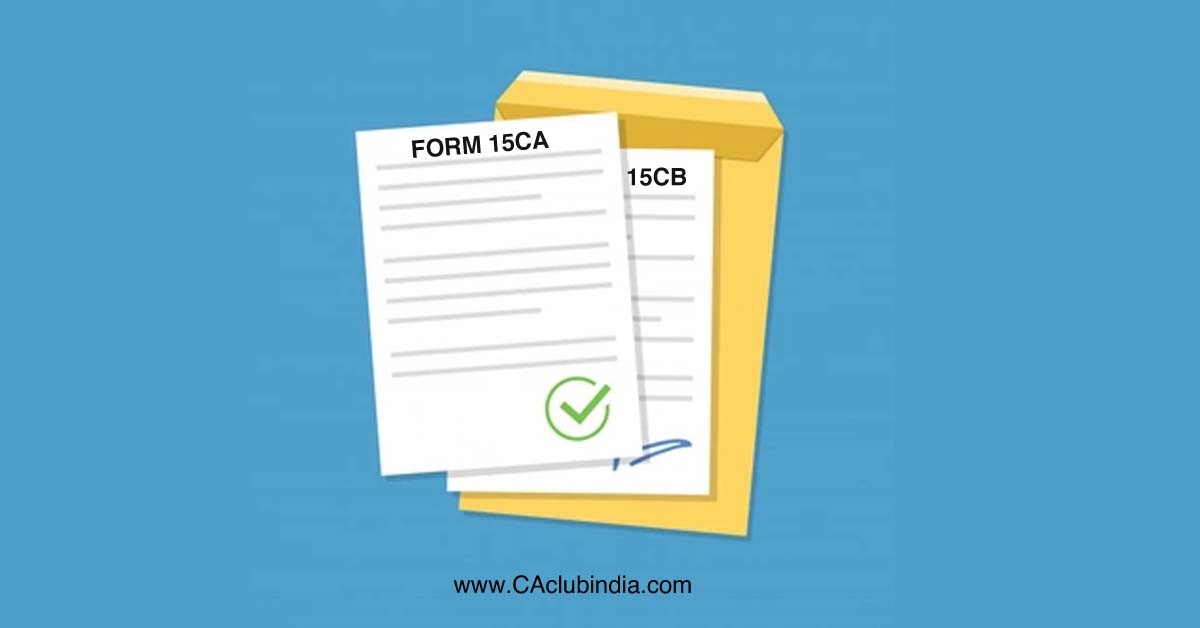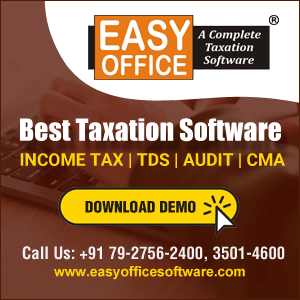Table of Contents
- Form 15CA
- Key points about Form 15CA
- Form 15CB
- Key points about Form 15CB
- Documents required for Form 15CA
- Documents required for Form 15CB
- Step-by-step process of reporting foreign remittances using Form 15CA in detail
- Specific reasons for introducing this section
- Consequences of Not Filing Form 15CA and 15CB on Time
The introduction of Form 15CA and Form 15CB in the Income Tax Act of India was primarily aimed at strengthening tax compliance and enhancing transparency in foreign remittances.
Reporting foreign transactions in Form 15CA and Form 15CB is a crucial compliance requirement for certain remittances made by Indian residents to non-residents. Let's look at each form and their respective compliance procedures:
Form 15CA
Form 15CA is an online form used to report remittances made by an Indian resident to a non-resident or foreign entity, if the payment exceeds certain specific limits ie Rs 5,00,0000 in a financial year. It applies to various types of payments like royalty, interest, dividends, consultancy fees, technical services, and more. The form is submitted electronically to the Income Tax Department to ensure proper tax deduction and reporting for foreign remittances. This Form is filled by Remitter.

Key points about Form 15CA
- The form is available on the Income Tax Department's website, and it must be filled out online.
- There are different categories in the form (PART A to PART D) and the appropriate category must be selected based on the nature of the remittance and the applicable section of the Income Tax Act.
- The form requires the PAN (Permanent Account Number) of the remitter (Indian resident) and the remittee (non-resident) along with other relevant details.
- Authorized dealers (banks or financial institutions) are responsible for verifying and ensuring that Form 15CA is submitted before making the foreign remittance.
- Certain remittances are exempted from the requirement of obtaining a certificate in Form 15CA.
Form 15CB
Form 15CB is a certificate issued by a Chartered Accountant (CA) where any payment or aggregate of payments exceeding Rs 5 lakhs in a F.Y, chargeable to income tax is made to Non-Resident, individual or Foreign company, where a CA verify that the provisions of the Income Tax Act, DTAA (Double Taxation Avoidance Agreement), Details and nature of payments, Compliance with Section 195 of the Income-tax, Rate of TDS deducted etc have been duly complied with.
Key points about Form 15CB
- Before submitting Form 15CA, the remitter must obtain Form 15CB from a CA. The form serves as an audit report for the remittance and is used to validate the information provided in Form 15CA.
- The CA examines the relevant documents, invoices, agreements, and DTAA provisions to determine the appropriate tax treatment for the remittance.
- Form 15CB is issued in a prescribed format and is essential for remittances that require RBI approval or are not covered under the tax exemption categories.
A detailed list of the documents typically required for Form 15CA and Form 15CB:
Documents required for Form 15CA
Remittance-related documents
- Invoice or agreement with the foreign recipient detailing the nature of the remittance.
- Details of the purpose of the remittance (e.g., for import of goods, payment for services, etc.).
- Declaration stating the nature of the remittance and the purpose for which it is being sent.
- PAN (Permanent Account Number) of the remitter (Indian resident):
- Copy of PAN card of the individual or the PAN certificate for companies or firms.
Reason for Lower/Nil deduction or a certificate under section 197/195
Foreign recipient's details
- Name and address of the foreign recipient.
- Country of the recipient's residence.
Bank details
- Details of the bank account from which the remittance will be made.
- Details of the foreign bank account to which the remittance will be sent.
Relevant Tax Residency Certificate (TRC) or No Permanent Establishment (PE) Certificate:If the recipient is claiming benefits under a Double Taxation Avoidance Agreement (DTAA), a Tax Residency Certificate issued by the recipient's home country tax authorities may be required.
For certain payments, a No PE Certificate may be required to confirm that the recipient has no Permanent Establishment in India.
Documents required for Form 15CB
- Invoice or Agreement: The invoice or agreement related to the foreign remittance, which outlines the nature of the payment and the contractual terms, must be provided.
- Tax Residency Certificate (TRC): A TRC issued by the remittee's tax authorities is required to avail of the benefits under the Double Taxation Avoidance Agreement (DTAA) between India and the country where the remittee is a tax resident.
- Form 10F: If the remittee claims the benefit of a lower withholding tax rate as per the DTAA, they should submit Form 10F along with Form 15CB.
- CA Certificate: Form 15CB itself acts as a certificate issued by a Chartered Accountant. The CA examines the relevant documents, verifies the nature of the payment, and certifies that the provisions of the Income Tax Act and DTAA have been duly complied with.
Step-by-step process of reporting foreign remittances using Form 15CA in detail
Step 1: Determine the Need for Form 15CA and Form 15CB
Assess whether the remittance falls under the specified categories that require submission of Form 15CA and Form 15CB. Not all foreign remittances require these forms; certain exemptions may apply.
Step 2: Obtain a Chartered Accountant (CA)
If Form 15CB is required, engage a qualified Chartered Accountant (CA) to conduct an examination of the remittance and issue the necessary certificate (Form 15CB). The CA will review the relevant documents, verify the nature of the payment, and ensure tax compliance.
Step 3: Prepare Form 15CB
Provide the CA with all the necessary documents, including invoices, agreements, and Tax Residency Certificate (TRC) from the remittee's country of residence if applicable. The CA will then prepare and issue Form 15CB certifying compliance with tax regulations.
Step 4: Fill out Form 15CA
Go to the Income Tax Department's official website (www.incometaxefilling.gov.in) and log in with your credentials.
Navigate to the 'e-file' tab and select 'Income Tax Forms' click on others and choose 'Form 15CA.'
Fill out the form online. The form consists of various parts, and you must provide accurate information about the remitter, remittee, nature of the remittance, tax liability, and other details.
Step 5: Select the Appropriate Category [Part A, Part B, Part C or Part D]
Choose the relevant category from the dropdown menu based on the purpose and nature of the remittance. The categories are defined under the provisions of the Income Tax Act.
Step 6: Verify the Details
Review the details you have entered in Form 15CA carefully to ensure accuracy and completeness by clicking on Review. After Reviewing the Details verify the form using a DSC.
After E- Verification Transaction ID and Acknowledgement No. will be generated.
Step 7: Submit Form 15CB and Form 15CA
Form 15CB, along with the signed Form 15CA and other supporting documents, must be submitted to the authorized dealer (bank or financial institution) through which the remittance is being made.
Step 8: Remit the Funds
The authorized dealer will verify the documents and ensure that Form 15CA has been submitted correctly. After verification, the remitter can proceed with the foreign remittance.
Specific reasons for introducing this section
The specific reasons for introducing this section are as follows
- Prevention of Tax Evasion: The Indian government introduced these forms to prevent tax evasion in cross-border transactions. By requiring individuals and businesses to report foreign remittances, the tax authorities can track international payments and ensure that appropriate taxes are deducted and paid.
- Monitoring Foreign Transactions: Form 15CA and Form 15CB help the government monitor and analyze foreign transactions effectively. This allows them to identify any suspicious or high-value transactions that may be indicative of tax avoidance or illicit activities.
- Track Foreign Exchange Outflows: The forms aid in monitoring foreign exchange outflows from India. This is crucial for the country's economic stability and managing its balance of payments.
- Verification by Chartered Accountants: The introduction of Form 15CB, to be issued by a qualified Chartered Accountant, adds an element of independent verification. The CA certifies that the remittance complies with the provisions of the Income Tax Act and any applicable Double Taxation Avoidance Agreements (DTAA).
- Ensuring DTAA Compliance: For remittances eligible for benefits under DTAA, Form 15CB validates the remittee's eligibility for the lower withholding tax rates or other tax benefits as per the tax treaty between India and the remittee's country.
- Reduction of Litigation: Proper reporting and verification of foreign remittances through Form 15CA and Form 15CB help reduce the possibility of tax-related disputes and litigation between taxpayers and the tax authorities.
Consequences of Not Filing Form 15CA and 15CB on Time
If a person, Fails to File 15CA & 15CB on time then, he shall be liable under section 271I of the Income tax Act 1961. This provision also attracts, if he furnishes inaccurate information. The Assessing Officer may direct that such person to pay a sum of one lakh rupees for Non-Compliance.








 CAclubindia
CAclubindia

